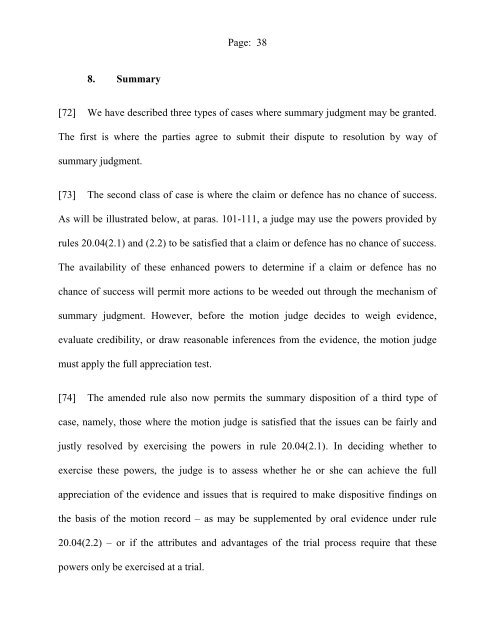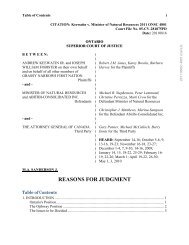COURT OF APPEAL FOR ONTARIO
COURT OF APPEAL FOR ONTARIO
COURT OF APPEAL FOR ONTARIO
You also want an ePaper? Increase the reach of your titles
YUMPU automatically turns print PDFs into web optimized ePapers that Google loves.
Page: 38<br />
8. Summary<br />
[72] We have described three types of cases where summary judgment may be granted.<br />
The first is where the parties agree to submit their dispute to resolution by way of<br />
summary judgment.<br />
[73] The second class of case is where the claim or defence has no chance of success.<br />
As will be illustrated below, at paras. 101-111, a judge may use the powers provided by<br />
rules 20.04(2.1) and (2.2) to be satisfied that a claim or defence has no chance of success.<br />
The availability of these enhanced powers to determine if a claim or defence has no<br />
chance of success will permit more actions to be weeded out through the mechanism of<br />
summary judgment. However, before the motion judge decides to weigh evidence,<br />
evaluate credibility, or draw reasonable inferences from the evidence, the motion judge<br />
must apply the full appreciation test.<br />
[74] The amended rule also now permits the summary disposition of a third type of<br />
case, namely, those where the motion judge is satisfied that the issues can be fairly and<br />
justly resolved by exercising the powers in rule 20.04(2.1). In deciding whether to<br />
exercise these powers, the judge is to assess whether he or she can achieve the full<br />
appreciation of the evidence and issues that is required to make dispositive findings on<br />
the basis of the motion record – as may be supplemented by oral evidence under rule<br />
20.04(2.2) – or if the attributes and advantages of the trial process require that these<br />
powers only be exercised at a trial.
















